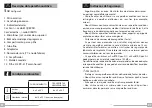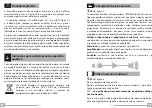
16
17
EN
EN
Intended Purpose
The intended purpose of the hearing aids is to selectively amplify
sound and transmit it to the ear to compensate for the hearing of
hearing impaired people.
• The m2 mBTE-Open Fit / m4 mBTE-Open Fit hearing aid is
intended to compensate for mild to severe (transmissive, mixed or
neurosensory) hearing loss and acute loss with preserved severity
(mixed or neurosensory). Its use is not intended for children nor
people with mental disabilities.
The prescription and adaptation of the hearing aids must be performed
by a hearing health professional, who will perform the programming
and specific adjustment for hearing loss and the morphology of the
user in a completely personalized manner. Therefore, using hearing
aids not prescribed by a professional or adapted for another person
can damage your hearing.
Instructions for the Elimination of the
Hearing Aid
When your hearing aid’s life comes to an end, it must be managed
differently from the urban solid waste collection system. All users are
obliged to deliver electrical or electronic equipment in a selective
collection point of their city, a specialized business or to your
hearing health professional in order to facilitate their treatment and
recycling as well as cooperating with the conservation, protection
and improvement of the environment.
In the European Union, the indicated device is covered
by Directive 2012/19/EU of the European Parliament and
of the Council on Waste of Electrical and Electronic
Equipment (WEEE)
Operation Principles
See Figure 3
BTE (Behind the Ear) is a type of anatomical hearing aids housed
behind the ear. They are powered by a battery and typically intended
to cover severe or profound hearing loss. All mechanical and
electronic components are contained in an ergonomic box. They are
adapted to the wearer’s ear by means of custom casts or adapters
from which a conductive tube comes out, attached to the bend of
the hearing aid or to the thin tube.
Casts and conductive tube / adapters and thin tube:
responsible
for conducting sound and allowing the device to be adapted to the
ear using a custom cast or adapter.
Microphone:
gathers sound and converts it into an electric signal.
Amplifier:
digital processor, which collects the signal and adapts it
to the parameters entered for each loss.
Earpiece:
converts the electrical signal into sound and transmits it,
already amplified, to the user’s ear.
Battery (insertion and change)
See Figure 4
Open the battery compartment
Remove the battery cover and position it with the “+” symbol facing
up. Close the battery compartment.
i
If the battery is not well-placed, the hearing aid will not
function.
To remove the battery, put the hearing aid upside down, open the
battery compartment and allow the battery to fall in your hand.
Microphone
Amplifier
Earpiece






























